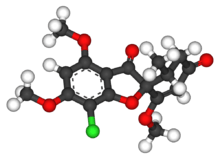Griseofulvin
 | |
 | |
| Clinical data | |
|---|---|
| Trade names | Gris-peg, Grifulvin V |
| AHFS/Drugs.com | Monograph |
| MedlinePlus | a682295 |
| Pregnancy category | |
| Routes of administration | Oral |
| ATC code | D01AA08 (WHO) D01BA01 (WHO) |
| Legal status | |
| Legal status | |
| Pharmacokinetic data | |
| Bioavailability | Highly variable (25 to 70%) |
| Metabolism | Liver (demethylation and glucuronidation) |
| Biological half-life | 9–21 hours |
| Identifiers | |
| |
| CAS Number |
126-07-8 |
| PubChem (CID) | 441140 |
| DrugBank |
DB00400 |
| ChemSpider |
389934 |
| UNII |
32HRV3E3D5 |
| KEGG |
D00209 |
| ChEBI |
CHEBI:27779 |
| ChEMBL |
CHEMBL562 |
| ECHA InfoCard | 100.004.335 |
| Chemical and physical data | |
| Formula | C17H17ClO6 |
| Molar mass | 352.766 g/mol |
| 3D model (Jmol) | Interactive image |
| |
| |
| (verify) | |
Griseofulvin (trade names: Gris-peg and Grifulvin V) is antifungal medication. It is used both in animals and humans, to treat fungal infections of the skin (commonly known as ringworm) and nail fungus. It is given by mouth.
Griseofulvin was discovered in the culture broth of certain species of the mold Penicillium in 1939.[1][2] It is on the World Health Organization's List of Essential Medicines, the most important medications needed in a basic health system.[3] It is produced industrially by fermenting the fungus Penicillium patulum.[4][5][6]
Medical uses
Griseofulvin is used orally only for dermatophytosis. It is ineffective topically. It is reserved for cases with nail, hair, or large body surface involvement.[7]
Side effects
Known side effects of griseofulvin include:
|
|
Mechanism
The drug binds to tubulin, interfering with microtubule function, thus inhibiting mitosis. It binds to keratin in keratin precursor cells and makes them resistant to fungal infections. The drug reaches its site of action only when hair or skin is replaced by the keratin-griseofulvin complex. Griseofulvin then enters the dermatophyte through energy-dependent transport processes and bind to fungal microtubules. This alters the processing for mitosis and also underlying information for deposition of fungal cell walls.
Biosynthetic process
The first step in the biosynthesis of griseofulvin by P. griseofulvin is the synthesis of the 14-carbon poly-β-keto chain by a type I iterative polyketide synthase (PKS) via iterative addition of 6 malonyl-CoA to an acyl-CoA starter unit. The 14-carbon poly-β-keto chain undergoes cyclization/aromatization, using cyclase/aromatase, respectively, through a Claisen and aldol condensation to form the benzophenone intermediate. The benzophenone intermediate is then methylated via S-adenosyl methionine (SAM) twice to yield griseophenone C. The griseophenone C is then halogenated at the activated site ortho to the phenol group on the left aromatic ring to form griseophenone B. The halogenated species then undergoes a single phenolic oxidation in both rings forming the two oxygen diradical species. The right oxygen radical shifts alpha to the carbonyl via resonance allowing for a stereospecific radical coupling by the oxygen radical on the left ring forming a tetrahydrofuranone species.[8] The newly formed grisan skeleton with a spiro center is then O-methylated by SAM to generate dehydrogriseofulvin. Ultimately, a stereoselective reduction of the olefin on dehydrogriseofulvin by NADPH affords griseofulvin.[9][10]
Brand names
- Crivicin
- Grifulvin V
- Gris OD 375 (Dr. Reddy's Laboratories)
- Gris-PEG (Valeant Pharmaceuticals)
- Grison-250 (V.I.P Pharma)
- Grisovin-FP (GlaxoSmithKline)
- S-Fulvin
References
- ↑ Michael Ash; Irene Ash (2004). Handbook of Preservatives. Synapse Info Resources. p. 406. ISBN 978-1-890595-66-1.
- ↑ Goldman, Leon (6 February 1960). "Current status of Griseofulvin". Journal of the American Medical Association. 172 (6): 532. doi:10.1001/jama.1960.03020060022006.
- ↑ "WHO Model List of EssentialMedicines" (PDF). World Health Organization. October 2013. Retrieved 22 April 2014.
- ↑ http://www.biochemj.org/bj/033/bj0330240.htm
- ↑ J.F. Grove, D. Ismay, J. Macmillan, T.P.C. Mulholland, M.A.T. Rogers, Chem. Ind. (London), 219 (1951).
- ↑ Grove, J. F.; MacMillan, J.; Mulholland, T. P. C.; Rogers, M. A. T. (1952). "762. Griseofulvin. Part IV. Structure". Journal of the Chemical Society (Resumed): 3977. doi:10.1039/JR9520003977.
- ↑ Tripathi. Textbook of Pharmacology. Jaypee Brothers. pp. 761–762. ISBN 81-8448-085-7.
- ↑ Birch, Arthur (1953). "Studies in relation to biosynthesis I. Some possible routes to derivatives of orcinol and phloroglucinol". Australian Journal of Chemistry. 6 (4): 360. doi:10.1071/ch9530360.
- ↑ Dewick, Paul M. (2009). Medicinal Natural Products: A Biosynthetic Approach (3rd ed.). UK: John Wiley & Sons Ltd. ISBN 0-471-97478-1.
- ↑ Harris, Constance (1976). "Biosynthesis of Griseofulvin". Journal of the American Chemical Society. 98 (17): 5380–5386. doi:10.1021/ja00433a053.
External links
- Griseofulvin (Medline Plus)
- Antifungal drug causes preferential apoptosis of cancer cells (Oncolink Cancer News)
- Anti-fungal Drug May Help Treat Cancer, Say Scientists at UC Santa Barbara
- dermnetnz Mentions alcohol, contraceptive interactions